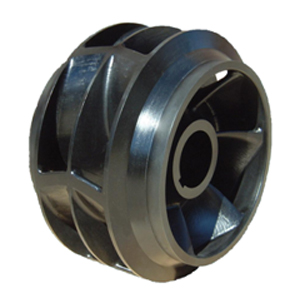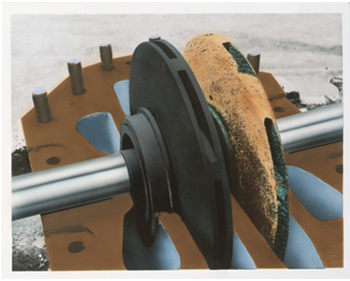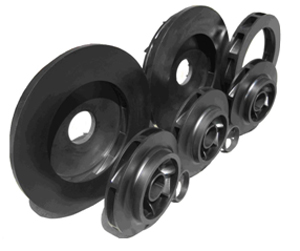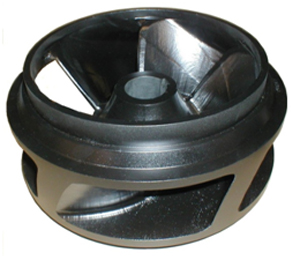Computer engineered, precision machined pumps and pump components maximize longevity and reliability.
Instead of simply repairing a pump or replacing it with a new pump of the same type or quality, other alternative solutions are available. With some pumps and pump parts, the reliability and quality of materials have deteriorated, forcing end users to replace or repair products more frequently and in a quicker timeframe.

Figure 1. An engineered impeller
Fortunately, specialized engineering companies manufacture machined, structural-engineered pumps, impellers, rings, sleeves, bearings, bushings and mechanical seals. These pumps and pump components are computer-engineered and designed and are precision machined (not cast or molded) with the objective of maximizing longevity and reliability. For example, the impeller vane geometry can be engineered to maximize efficiency and performance specifically for the end user's system. The best part of these alternatives is that they are often competitively priced.
Benefits of Engineered Components
Some companies focus on innovative solutions for corrosion, erosion, radial thrust and cavitation applications. They manufacture structural, graphite-composite, computer-engineered and generated replacement pumps and pump parts which are 100 percent machined on five- to eight-axis robotic machining centers. They can manufacture parts, even obsolete parts, for any centrifugal pump. Advanced composite manufacturers focus on extending the life of the part, which is a different concept from traditional pump manufacturers who make money selling spare parts.
Advance structural composite materials never corrode in salt water, wastewater, or chlorinated water applications and are excellent for many chemical applications. They are gradually taking market share from more traditional materials and products.
These impellers and pumps are 100 percent machined on the inside as well as the outside from solid blocks of the structural composite, which offers Superior Mechanical Strength, Perfect Balance, Better Performance, Smoother Surfaces, and Longer Life.

Figure 2. Both impellers ran for three years. The structural composite impeller of Figure 1 looks like new.
The key benefits of using the new alternative solutions for pumps, impellers, rings and pump parts are:
- They are corrosion resistant and chemical resistant.
- They never corrode in salt water, wastewater or chlorinated water.
- The impellers are cavitation and erosion resistant.
- Superior to metallic pumps in salt water, wastewater and chlorinated water services.
- Composite parts and pumps operate at higher efficiencies.
- At 1/6 the weight of bronze or stainless steel, they are lighter weight, and the high strength to weight ratio of the engineered composite impeller means a substantial reduction in start-up load, longer bearing and mechanical seal life and less shaft deflection and vibration.
- The impellers have perfect balance, and they maintain this perfect balance over the life of the pump.
- They eliminate electrolysis. These engineered, structural composites are inert, which means that they do not conduct electrolysis and therefore save or prolong the life of the pump casing even if it is metallic.
- These pumps and parts increase performance, longevity and reliability.
- They are 100 percent precision machined from one piece. They are machined on the inside as well as the outside from solid blocks of the structurally engineered composite, which offers superior mechanical strength, perfect balance, better performance, smoother surfaces and longer life.
- These pumps and parts can maintain tighter seals. Engineered impellers and casing rings will not gall or seize like metallic rings. Therefore, they can operate with a tighter clearance permitting less leakage through the rings and impeller, which increases pump efficiency. Additionally, the composite casing rings seal the casing which prevents the “wash out” of the casing ring landing areas that is a common centrifugal pump maintenance problem.
- Because of the high efficiency and the precision machined design of the engineered impellers, they are light weight and have noise absorbing characteristics. Therefore, noise and vibration are reduced in the pump.
Impellers machined from these alternative products offer tremendous advantages over traditional products cast from metal. Many of these impellers and casing rings have been used successfully since 1955 in the marine, naval, industrial and chemical markets. They have outlasted and outperformed products manufactured from bronze, stainless steel, duplex steel, monel and even titanium.

Figure 3. Engineered composite impellers, casing rings and diffusers do not corrode, are light weight, more efficient and have perfect balance.
Lower Costs and Increased Performance
Alternative composite solutions for impellers and rings are appropriate for new, repair or retrofit applications. Wear of other pump parts including the pump casing are greatly reduced because of the impeller's balance, light weight, self-lubrication, and sealing, and its corrosion, erosion, and cavitation resistance. This requires far less expense for replacement of parts and downtime and can offer years of trouble-free performance.
Superior Hydraulic Performance
Because alternative solution impellers are computer engineered, designed and precision machined, the impeller vane geometry can be engineered to maximize efficiency and performance. Problems such as recirculation, radial thrust and cavitation can be minimized or eliminated by upgrading to composite impellers and rings. Impeller vane shapes can easily be modified to provide the best shape for specific applications and performance requirements.
Figure 4 (below). Composite impeller vanes can be engineered for maximum efficiency

It is all too common a problem. A pump for one specific performance is purchased, and when it is put into service in the application, the pump operates at another point that is different from the original best efficiency point (BEP) of the pump because of your system requirements. In addition to being inefficient, when you operate the pump away from the BEP, it causes a multitude of problems, including:
- Excessive noise and vibration
- Shaft oscillation
- Cavitation
- Premature wear
- Failure of the mechanical seals, bearings, rings, sleeves and impellers.
- Shaft will break (in extreme cases)
Fortunately, these problems can be easily resolved by installing composite impellers and rings, which have been re-engineered to match the system requirements. Not only is the efficiency of the pump improved, but also the reliability and longevity of the complete pump can be substantially improved.
Pumps & Systems, May 2011


